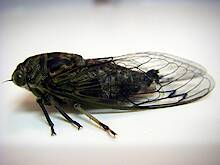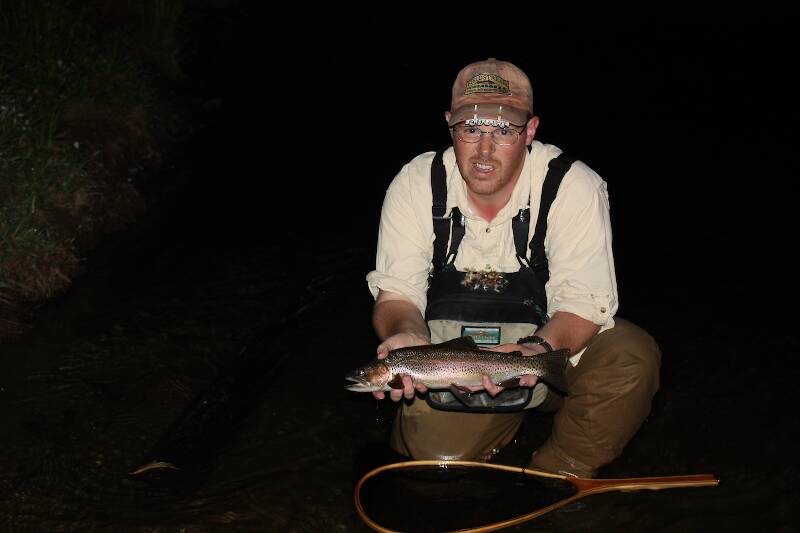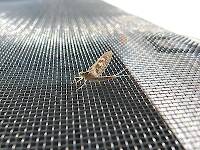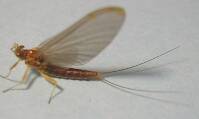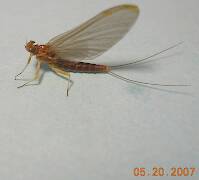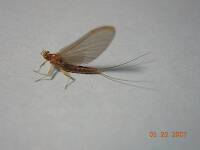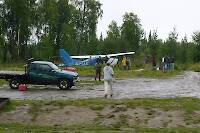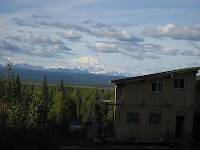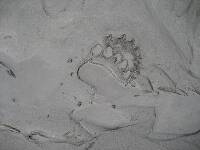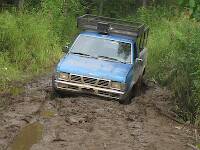
Hex Mayflies
Hexagenia limbata
The famous nocturnal Hex hatch of the Midwest (and a few other lucky locations) stirs to the surface mythically large brown trout that only touch streamers for the rest of the year.
Featured on the forum

This one was surprisingly straightforward to identify. The lack of a sclerite at the base of the lateral hump narrows the field quite a bit, and the other options followed fairly obvious characteristics to Clostoeca, which only has one species, Clostoeca disjuncta.

Troutnut is a project started in 2003 by salmonid ecologist Jason "Troutnut" Neuswanger to help anglers and
fly tyers unabashedly embrace the entomological side of the sport. Learn more about Troutnut or
support the project for an enhanced experience here.
DayTripper on May 14, 2008May 14th, 2008, 4:31 pm EDT
Spent a couple hours collecting/photographing more bugs on the Battenkill this evening. There are 14 different bugs I need to find latin names for. I think a few are the same species, but there were some subtle differences so I didn't delete the pics.
I saw the biggest hellgrammite I've seen in my life, and it got away. It must have been close to 4" long! I know where he lives...
Anyways, just click the pictures to enlarge. Body size is shown for each specimen. Any help is GREATLY appreciated. Also, sorry for sending you guys to another page, there's just a lot of pics, lol.
http://daytripperblog.com/fish-food/battenkill-river-5-14-08-temp-page/
I saw the biggest hellgrammite I've seen in my life, and it got away. It must have been close to 4" long! I know where he lives...
Anyways, just click the pictures to enlarge. Body size is shown for each specimen. Any help is GREATLY appreciated. Also, sorry for sending you guys to another page, there's just a lot of pics, lol.
http://daytripperblog.com/fish-food/battenkill-river-5-14-08-temp-page/
Shawnny3 on May 15, 2008May 15th, 2008, 12:18 am EDT
I saw the biggest hellgrammite I've seen in my life, and it got away. It must have been close to 4" long! I know where he lives...
Better hope he doesn't know where you live. Wouldn't want one of those crawling into your bedroom while you're sleeping...
-Shawn
Jewelry-Quality Artistic Salmon Flies, by Shawn Davis
www.davisflydesigns.com
www.davisflydesigns.com
JOHNW on May 15, 2008May 15th, 2008, 1:55 am EDT
Alright I'm by no means good at the latin side of things but #4 looks like Isonychia sp.
#3 is (I think) what I know as a Fishfly perhaps (Nigrona-?).
JW
#3 is (I think) what I know as a Fishfly perhaps (Nigrona-?).
JW
"old habits are hard to kill once you have gray in your beard" -Old Red Barn
DayTripper on May 15, 2008May 15th, 2008, 2:36 am EDT
Thanks John,
I had #4 as an Iso, too. Then #3 as a hellgrammite. The ones that are giving me trouble are 2,5,8, and 14.
I'm pretty sure 8 is an invaria nymph, but it doesn't really have the lighter mid-abdominal segments, or at least they're not as pronounced as a couple of the other invaria nymphs pictured. (at least I think they' invaria, lol)
Here's where I'm at so far
http://daytripperblog.com/2008/05/15/let-there-be-bugs/
I had #4 as an Iso, too. Then #3 as a hellgrammite. The ones that are giving me trouble are 2,5,8, and 14.
I'm pretty sure 8 is an invaria nymph, but it doesn't really have the lighter mid-abdominal segments, or at least they're not as pronounced as a couple of the other invaria nymphs pictured. (at least I think they' invaria, lol)
Here's where I'm at so far
http://daytripperblog.com/2008/05/15/let-there-be-bugs/
Creno on May 15, 2008May 15th, 2008, 3:39 am EDT
Daytripper - the Limnephilid appears to be Pycnopsyche and if the other two caddis pictures are of the same specimen it appears to be one of the Hydropsyche morosa group, possibly H.morosa.
DayTripper on May 15, 2008May 15th, 2008, 3:56 am EDT
Thank you Creno! The other caddis is a different specimen. It's a net spinning caddis, not sure what species yet though. The reason the two pics look different is I enhanced the top one a little differently so you guys could see the mouth parts a little better.
JOHNW on May 15, 2008May 15th, 2008, 6:09 am EDT
Day,
I was leaning away from hellgramite for #3 as I failed to notice any gill tufts at the base of the legs. However I will reiterate that to me the picture reads black ostrich real bugger with short hackle trimmed top and bottom.
And #8 reads to my mind as a "big old Pheasant tail nymph" again teh bain of thinking pattern first over identification. But it is a burden I accept whole heartedly.
JW
I was leaning away from hellgramite for #3 as I failed to notice any gill tufts at the base of the legs. However I will reiterate that to me the picture reads black ostrich real bugger with short hackle trimmed top and bottom.
And #8 reads to my mind as a "big old Pheasant tail nymph" again teh bain of thinking pattern first over identification. But it is a burden I accept whole heartedly.
JW
"old habits are hard to kill once you have gray in your beard" -Old Red Barn
Quillgordon on May 15, 2008May 15th, 2008, 10:22 am EDT
DT,
Specimen #15 looks like an Epeorus nymph(clinger).
Maybe 'Epeorus pleuralis........ Quill gordon, but that hatch should be over by now!
John...
Specimen #15 looks like an Epeorus nymph(clinger).
Maybe 'Epeorus pleuralis........ Quill gordon, but that hatch should be over by now!
John...
Flyfishing is a state of mind! .............. Q.g.
C/R........barbless
C/R........barbless
DayTripper on May 15, 2008May 15th, 2008, 10:37 am EDT
Thanks Quill Gordon,
I was thinking Epeorus, too, but am stuck on a species. This one was only 4mm, maybe it's a juvenile? If you look at color plate XIV in Hatches II, it appears to be a dead match for the Epeorus nymph pictured on the middle-left, but they didn't name what species it is.
I was thinking Epeorus, too, but am stuck on a species. This one was only 4mm, maybe it's a juvenile? If you look at color plate XIV in Hatches II, it appears to be a dead match for the Epeorus nymph pictured on the middle-left, but they didn't name what species it is.
Taxon on May 15, 2008May 15th, 2008, 11:39 am EDT
Alex-
Yes, certainly an early instar nymph. I believe Epeorus to be univoltine, so it's likely the offspring of an early-spring-emerging species.
This one was only 4mm, maybe it's a juvenile?
Yes, certainly an early instar nymph. I believe Epeorus to be univoltine, so it's likely the offspring of an early-spring-emerging species.
Taxon on May 15, 2008May 15th, 2008, 1:21 pm EDT
Alex-
Sample #2 is Anthopotamus, likely A. distinctus.
Sample #2 is Anthopotamus, likely A. distinctus.
Quillgordon on May 16, 2008May 16th, 2008, 1:04 am EDT
Taxon,
Yes, certainly an early instar nymph. I believe Epeorus to be univoltine, so it's likely the offspring of an early-spring-emerging species.
.................................................................
What is the normal life cycle(time) for an 'epeorus' nymph such as this?
Do you have a link for the life cycles of the different families of mayflies; since most of them are different.
Is this particular nymph(size) unusual for time of the year, since quill gordons probably hatched in late april ?
John
Yes, certainly an early instar nymph. I believe Epeorus to be univoltine, so it's likely the offspring of an early-spring-emerging species.
.................................................................
What is the normal life cycle(time) for an 'epeorus' nymph such as this?
Do you have a link for the life cycles of the different families of mayflies; since most of them are different.
Is this particular nymph(size) unusual for time of the year, since quill gordons probably hatched in late april ?
John
Flyfishing is a state of mind! .............. Q.g.
C/R........barbless
C/R........barbless
Taxon on May 16, 2008May 16th, 2008, 9:49 am EDT
John-
I believe Epeorus to be univoltine, as the northwestern residing species (E. albertae, E. deceptivus, E. grandis, and E. longimanus) are listed thusly on The Xerces Society CD, Stream Bugs as Biomonitors. Univoltine means they have one generation per year.
No. The only two sources source of life cycle duration information (to which I have access) are the above reference, which only lists Northwest residing aquatic insects, and the book, An Introduction to the Aquatic Insects Of North America, edited by Merritt & Cummins, whose Life History table doesn't list Epeorus among the Heptageniids, at least in the Third Edition, which I have.
I would think not, assuming it is offspring from an early spring emerger.
What is the normal life cycle(time) for an 'epeorus' nymph such as this?
I believe Epeorus to be univoltine, as the northwestern residing species (E. albertae, E. deceptivus, E. grandis, and E. longimanus) are listed thusly on The Xerces Society CD, Stream Bugs as Biomonitors. Univoltine means they have one generation per year.
Do you have a link for the life cycles of the different families of mayflies; since most of them are different.
No. The only two sources source of life cycle duration information (to which I have access) are the above reference, which only lists Northwest residing aquatic insects, and the book, An Introduction to the Aquatic Insects Of North America, edited by Merritt & Cummins, whose Life History table doesn't list Epeorus among the Heptageniids, at least in the Third Edition, which I have.
Is this particular nymph(size) unusual for time of the year, since quill gordons probably hatched in late april ?
I would think not, assuming it is offspring from an early spring emerger.
Quillgordon on May 16, 2008May 16th, 2008, 12:28 pm EDT
Taxon,
Thank you for that information.
I was just curious how long the different stages of a mayfly, such as 'epeorus' takes. I think I was surprised to see a developed nymph stage of a new brood that probably emerged/mated in late april.
I thought the 'egg stage' of mayflies was longer than one month' perhaps 2 or 3 months. That is why I asked for a link/reference to mayfly life cycles.
So a nymph like that would spend another year for full development before emergence in april ?
Thank you for that information.
I was just curious how long the different stages of a mayfly, such as 'epeorus' takes. I think I was surprised to see a developed nymph stage of a new brood that probably emerged/mated in late april.
I thought the 'egg stage' of mayflies was longer than one month' perhaps 2 or 3 months. That is why I asked for a link/reference to mayfly life cycles.
So a nymph like that would spend another year for full development before emergence in april ?
Flyfishing is a state of mind! .............. Q.g.
C/R........barbless
C/R........barbless
Taxon on May 16, 2008May 16th, 2008, 2:12 pm EDT
John-
The duration of the egg lifestage varies by species, and is further impacted by water temperature. However, I expect it would average several weeks for mayflies. One exception to that would be Callibaetis, whose eggs are already mature at time of oviposition, after having spent ~5 days (following mating) maturing in the female imago.
Louis-
Am hoping my sharing of this information will not exceed your threshold for sexual specificity. However, I'm probably okay, as I didn't refer to any "organs of origin" by name.
The duration of the egg lifestage varies by species, and is further impacted by water temperature. However, I expect it would average several weeks for mayflies. One exception to that would be Callibaetis, whose eggs are already mature at time of oviposition, after having spent ~5 days (following mating) maturing in the female imago.
Louis-
Am hoping my sharing of this information will not exceed your threshold for sexual specificity. However, I'm probably okay, as I didn't refer to any "organs of origin" by name.
GONZO on May 17, 2008May 17th, 2008, 9:33 am EDT
Alex,
Your Perlidae specimen looks like Paragnetina media to me. This is a very common and tolerant perlid, also known as the "embossed stone." You should see them emerging on streamside rocks throughout June.
I wouldn't be surprised if all the pictured Ephemerella nymphs were invaria. Despite the name, the color and markings of invaria nymphs show a lot of variation. On the Yellow Breeches, I see them in brown, olive, amber, and nearly black--all on the same rock.
John's right that your "hellgrammite" is a fishfly larva. The term "hellgrammite" is often loosely used as a common name for both dobsonfly and fishfly larvae. The big 4" specimen you saw would have been a dobsonfly larva (a true hellgrammite).
Your Perlidae specimen looks like Paragnetina media to me. This is a very common and tolerant perlid, also known as the "embossed stone." You should see them emerging on streamside rocks throughout June.
I wouldn't be surprised if all the pictured Ephemerella nymphs were invaria. Despite the name, the color and markings of invaria nymphs show a lot of variation. On the Yellow Breeches, I see them in brown, olive, amber, and nearly black--all on the same rock.
John's right that your "hellgrammite" is a fishfly larva. The term "hellgrammite" is often loosely used as a common name for both dobsonfly and fishfly larvae. The big 4" specimen you saw would have been a dobsonfly larva (a true hellgrammite).
Shawnny3 on May 20, 2008May 20th, 2008, 11:11 am EDT
I appreciate your posting this thread, DayTripper. I'm one of those guys for whom insect ID has always been difficult, and I love these threads where people post bugs and ask what they are. I like to make my guesses and then check them against the experts' IDs. I am quite proud of how many I knew or was close on this time. Even some of the Latin names are starting to sink in.
And I think I'm not alone when I say that you should never feel bad about asking a lot of questions on this forum. That's exactly what it's for. I think the experts on the forum like answering questions (or they wouldn't be here), and there are always many of us who find their answers to questions quietly instructive, as I have.
-Shawn
And I think I'm not alone when I say that you should never feel bad about asking a lot of questions on this forum. That's exactly what it's for. I think the experts on the forum like answering questions (or they wouldn't be here), and there are always many of us who find their answers to questions quietly instructive, as I have.
-Shawn
Jewelry-Quality Artistic Salmon Flies, by Shawn Davis
www.davisflydesigns.com
www.davisflydesigns.com
Quick Reply
Related Discussions
Topic
Replies
Last Reply
4
Dec 22, 2009
by Oldredbarn
by Oldredbarn
0
May 3, 2007
by Troutnut
by Troutnut
3
Jul 22, 2014
by Entoman
by Entoman
11
Jul 11, 2016
by Chiquis
by Chiquis
1
May 17, 2016
by Bnorikane
by Bnorikane


